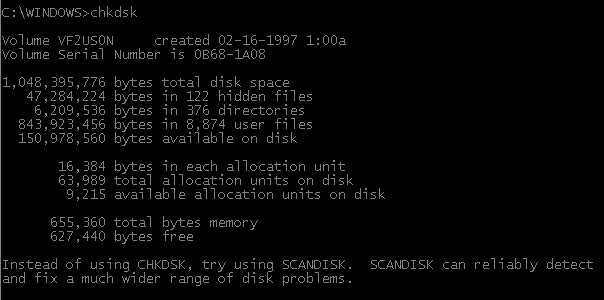

|
31.670 bytes |
Service Hints & Tips |
Document ID: BMOE-3Q8PBZ |
Aptiva - How to run ScanDisk or Checkdisk
Applicable to: World-Wide
Under Windows 95 or 98, ScanDisk may be run from Windows or from DOS.
To run Scandisk:
From Windows 95 or 98:
1. Click on "Start", "Programs", "Accessories", "System Tools", and on "ScanDisk".
2. At "Scandisk" screen, select desired drive to test. Click on "Thorough". Select "Automatically fix errors". Click on "Start" to begin ScanDisk process. This procedure will take a while, depending upon the size of the drive.
3. When ScanDisk is completed, you will see the "ScanDisk Results" screen containing the results of the testing procedure. If there are bad sectors found, this indicates a hardware problem.
From Windows DOS prompt:
1. Click on "Start", "Programs", MS-DOS Prompt.
2. Type "scandisk" and press "Enter" key.
3. At "ScanDisk" screen, select desired drive to test. Click on "Thorough". Select "Automatically fix errors". Click on "Start" to begin ScanDisk process. This procedure will take a while, depending upon the size of the drive.
4. When ScanDisk is completed, you will see the "ScanDisk Results" screen containing the results of the testing procedure. If there are bad sectors found, this indicates a hardware problem.
5. Type "exit" and press "Enter" key to return to Windows.
From a true MS DOS prompt:
1. Go to an MS DOS prompt using any of the following methods:
- Click on "Start", "Shut Down", "Restart computer in MS DOS mode", "Yes". Then type "scandisk" and press "Enter" key, or:
- Boot computer, press "F8" key at the black "Starting Windows 95" screen. Press "6" or "7" and "Enter" key to go to a command prompt. Then type "scandisk" and press "Enter" key, or:
- On "M" and "A" series computers preloaded with Windows 95, boot with Recovery diskette and type "n" to recover original software. Press "Enter" key. Type "scandisk c:" and press "Enter" key, or:
- On 2136, 2159, 2161, 2162, 2176 series, boot with Diagnostic CD. At menu, press "0" (zero) to take you to an A:\ prompt. Type "C:\windows\command\scandisk" and press "Enter" key.
2. ScanDisk will perform 5 brief tests of the file structure. If a "Problem Found" screen comes up with information about finding lost files, you will have options to "Save", "Delete", "Don't Fix It", or "More Info." Unless you have a reason to save the file, press "L" for "Delete". You will then receive an option to create an "Undo" diskette. Unless you have a reason to, press "S" for "Skip Undo".
3. When the file structure testing is completed, you will be asked if you want to perform a surface scan now. Press "Enter" key to continue. The "Surface Scan" screen will come up with a graphic display of the clusters on the hard drive. This procedure will take a while, depending upon the size of the drive.
4. After ScanDisk has completed testing the file structure a screen will display the results of the tests. This log may be saved if you wish. If there are bad sectors found, this indicates a hardware problem. Press 'Enter' key to exit that screen, then type "x;" to exit.
To Run Checkdisk:
- Click on "Start", "Programs", MS-DOS Prompt. Type "chkdsk" and press "Enter" key, or:
- Restart computer in MS DOS mode. Type "chkdsk" and press "Enter" key, or:
- Boot computer, press "F8" key at the black "Starting Windows 95" screen. Press "6" or "7" and "Enter" key to go to a command prompt. Type "chkdsk" and press "Enter" key, or:
- On "M" series computers preloaded with OS/2, boot from recovery diskettes. From the recovery menu select the option "Go to OS/2 Command Prompt". From the A:\ prompt type "chkdsk c:" and press "Enter" key, or:
- On "M" and "A" series computers preloaded with Windows 95, boot with recovery diskette and type "n" to recover original software. Press "Enter" key. Type "chkdsk c:" and press "Enter" key, or:
- On 2136, 2159, 2161, 2162, 2176 series, boot with Diagnostic CD. At menu, press "0" (zero) to take you to an A:\ prompt. Type "chkdsk c:" and press "Enter" key, or:
Note: If you wish to have Checkdisk repair lost allocation units on hard drive, type "chkdsk/f." The "f" switch relays the command to also "fix" errors that are found. If you use this option, you will receive an option to verify running chkdsk instead of scandisk and an option to save lost allocation units as files. There is usually no need to save these as files. The Checkdisk screen should resemble the figure below. The figures will be different on your system.

Checkdisk screen
If Checkdisk finds a large number (more than 1000) bad sectors, this indicates a hardware problem. ScanDisk is a more thorough testing procedure than Checkdisk but takes longer to perform.
|
Search Keywords |
| |
|
Hint Category |
Utility Software, Windows 95, Windows 98 | |
|
Date Created |
29-12-97 | |
|
Last Updated |
14-12-98 | |
|
Revision Date |
14-12-99 | |
|
Brand |
IBM Aptiva | |
|
Product Family |
Aptiva | |
|
Machine Type |
2134, 2136, 2137, 2138, 2139, 2140, 2142, 2144, 2153, 2156, 2158, 2159, 2161, 2162, 2163, 2164, 2168, 2176 | |
|
Model |
All | |
|
TypeModel |
| |
|
Retain Tip (if applicable) |
| |
|
Reverse Doclinks |